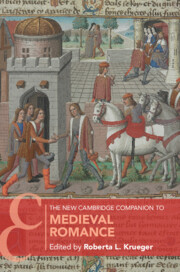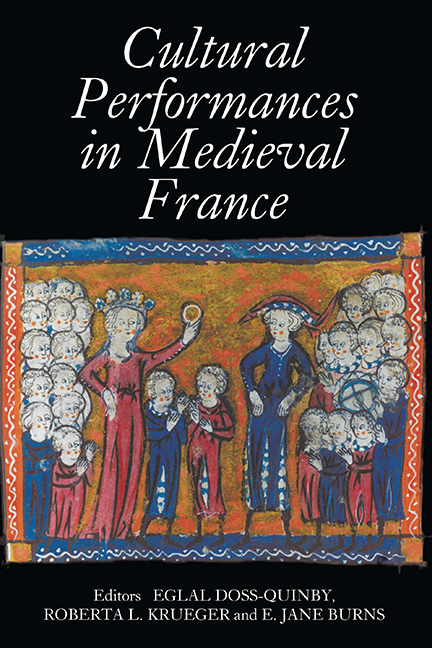38 results
Bibliography of Editions and Translations
-
- Book:
- The New Cambridge Companion to Medieval Romance
- Published online:
- 11 May 2023
- Print publication:
- 25 May 2023, pp 272-284
-
- Chapter
- Export citation
Contents
-
- Book:
- The New Cambridge Companion to Medieval Romance
- Published online:
- 11 May 2023
- Print publication:
- 25 May 2023, pp v-vi
-
- Chapter
- Export citation
Introduction
-
-
- Book:
- The New Cambridge Companion to Medieval Romance
- Published online:
- 11 May 2023
- Print publication:
- 25 May 2023, pp 1-13
-
- Chapter
- Export citation
Chronology
-
- Book:
- The New Cambridge Companion to Medieval Romance
- Published online:
- 11 May 2023
- Print publication:
- 25 May 2023, pp xiii-xviii
-
- Chapter
- Export citation
Contributors
-
- Book:
- The New Cambridge Companion to Medieval Romance
- Published online:
- 11 May 2023
- Print publication:
- 25 May 2023, pp viii-xi
-
- Chapter
- Export citation
Acknowledgments
-
- Book:
- The New Cambridge Companion to Medieval Romance
- Published online:
- 11 May 2023
- Print publication:
- 25 May 2023, pp xii-xii
-
- Chapter
- Export citation
Copyright page
-
- Book:
- The New Cambridge Companion to Medieval Romance
- Published online:
- 11 May 2023
- Print publication:
- 25 May 2023, pp iv-iv
-
- Chapter
- Export citation
Index
-
- Book:
- The New Cambridge Companion to Medieval Romance
- Published online:
- 11 May 2023
- Print publication:
- 25 May 2023, pp 285-302
-
- Chapter
- Export citation
Figures
-
- Book:
- The New Cambridge Companion to Medieval Romance
- Published online:
- 11 May 2023
- Print publication:
- 25 May 2023, pp vii-vii
-
- Chapter
- Export citation

The New Cambridge Companion to Medieval Romance
-
- Published online:
- 11 May 2023
- Print publication:
- 25 May 2023
Staging Female Authority in Chantilly MS 522: Marguerite de Navarre's La Coche
- from Part IV - Female Authority: Networks and Influence
-
-
- Book:
- Founding Feminisms in Medieval Studies
- Published by:
- Boydell & Brewer
- Published online:
- 05 July 2016
- Print publication:
- 17 March 2016, pp 187-204
-
- Chapter
- Export citation
Frontmatter
-
- Book:
- Cultural Performances in Medieval France
- Published by:
- Boydell & Brewer
- Published online:
- 24 October 2017
- Print publication:
- 15 March 2007, pp i-vi
-
- Chapter
- Export citation
Contributors
-
- Book:
- Cultural Performances in Medieval France
- Published by:
- Boydell & Brewer
- Published online:
- 24 October 2017
- Print publication:
- 15 March 2007, pp xiii-xiv
-
- Chapter
- Export citation
Introduction
-
-
- Book:
- Cultural Performances in Medieval France
- Published by:
- Boydell & Brewer
- Published online:
- 24 October 2017
- Print publication:
- 15 March 2007, pp xv-xxii
-
- Chapter
- Export citation
PART I - POETIC AND MUSICAL PERFORMANCES
-
- Book:
- Cultural Performances in Medieval France
- Published by:
- Boydell & Brewer
- Published online:
- 24 October 2017
- Print publication:
- 15 March 2007, pp 1-2
-
- Chapter
- Export citation
PART V - RE–ENACTMENTS AND LEGACIES
-
- Book:
- Cultural Performances in Medieval France
- Published by:
- Boydell & Brewer
- Published online:
- 24 October 2017
- Print publication:
- 15 March 2007, pp 233-234
-
- Chapter
- Export citation
PART IV - PERSUASIVE PERFORMANCES
-
- Book:
- Cultural Performances in Medieval France
- Published by:
- Boydell & Brewer
- Published online:
- 24 October 2017
- Print publication:
- 15 March 2007, pp 179-180
-
- Chapter
- Export citation

Cultural Performances in Medieval France
- Essays in Honor of Nancy Freeman Regalado
-
- Published by:
- Boydell & Brewer
- Published online:
- 24 October 2017
- Print publication:
- 15 March 2007
Contents
-
- Book:
- Cultural Performances in Medieval France
- Published by:
- Boydell & Brewer
- Published online:
- 24 October 2017
- Print publication:
- 15 March 2007, pp vii-x
-
- Chapter
- Export citation
PART II - PERFORMING SEXUAL AND SOCIAL IDENTITIES
-
- Book:
- Cultural Performances in Medieval France
- Published by:
- Boydell & Brewer
- Published online:
- 24 October 2017
- Print publication:
- 15 March 2007, pp 55-56
-
- Chapter
- Export citation



